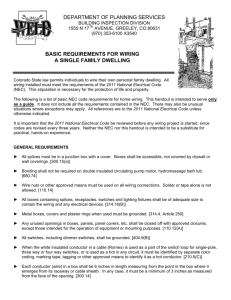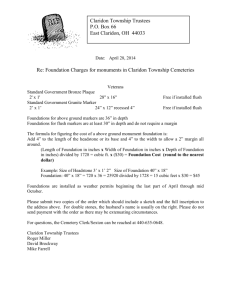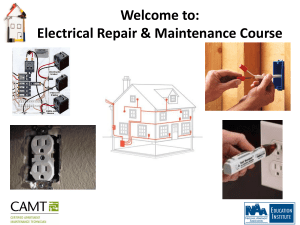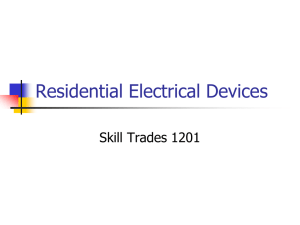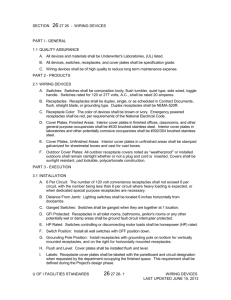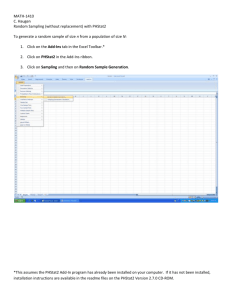Electrical Permit Information for Homeowners
advertisement
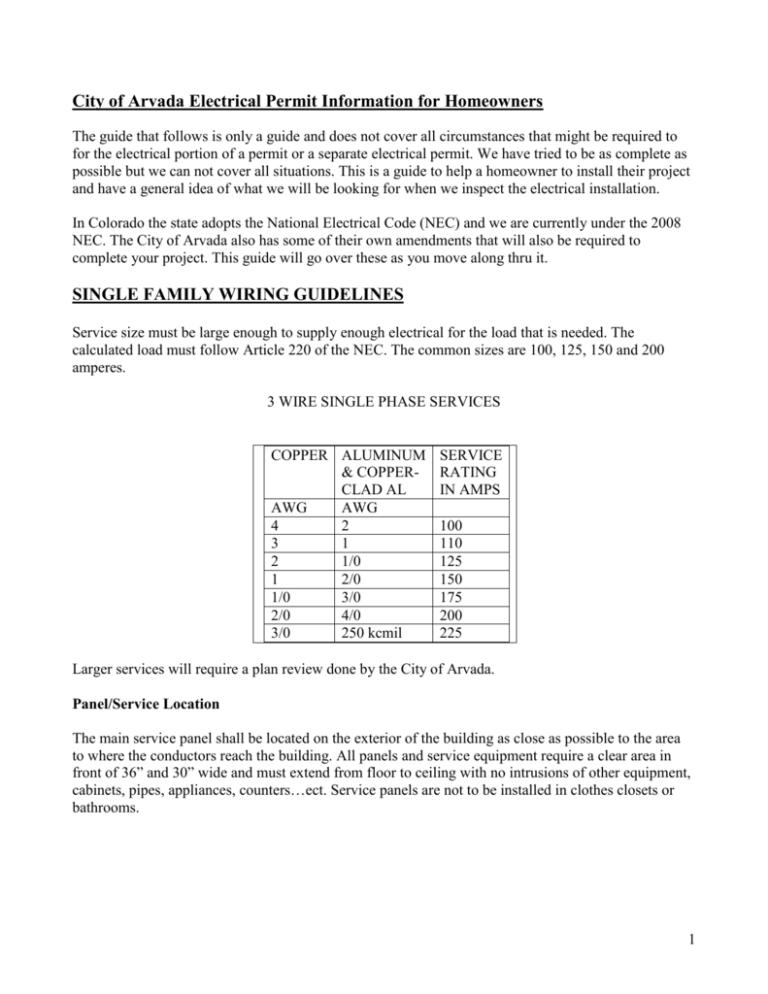
City of Arvada Electrical Permit Information for Homeowners The guide that follows is only a guide and does not cover all circumstances that might be required to for the electrical portion of a permit or a separate electrical permit. We have tried to be as complete as possible but we can not cover all situations. This is a guide to help a homeowner to install their project and have a general idea of what we will be looking for when we inspect the electrical installation. In Colorado the state adopts the National Electrical Code (NEC) and we are currently under the 2008 NEC. The City of Arvada also has some of their own amendments that will also be required to complete your project. This guide will go over these as you move along thru it. SINGLE FAMILY WIRING GUIDELINES Service size must be large enough to supply enough electrical for the load that is needed. The calculated load must follow Article 220 of the NEC. The common sizes are 100, 125, 150 and 200 amperes. 3 WIRE SINGLE PHASE SERVICES COPPER ALUMINUM & COPPERCLAD AL AWG AWG 4 2 3 1 2 1/0 1 2/0 1/0 3/0 2/0 4/0 3/0 250 kcmil SERVICE RATING IN AMPS 100 110 125 150 175 200 225 Larger services will require a plan review done by the City of Arvada. Panel/Service Location The main service panel shall be located on the exterior of the building as close as possible to the area to where the conductors reach the building. All panels and service equipment require a clear area in front of 36” and 30” wide and must extend from floor to ceiling with no intrusions of other equipment, cabinets, pipes, appliances, counters…ect. Service panels are not to be installed in clothes closets or bathrooms. 1 Grounding All service equipment needs to be grounded per Article 250 of the NEC – the neutral must be bonded to the grounding electrode and the service enclosure as stated in Article 250.50 of the NEC. 250.50 Grounding Electrode System –All grounding electrodes as described in 250.52(A)(1) through (A) (7) that are present at each building or structure served shall be bonded together to form the grounding electrode system. Grounding Electrodes- Metal underground water pipe, Metal Frame of the building or structure, Concrete-encased electrode, Ground ring, Rod and pipe electrodes, Plate electrodes and other listed electrodes. Not permitted to be used as a grounding electrode - Metal underground gas piping or Aluminum. All new structures are required to have a concrete encased electrode if a concrete foundation is used. 250.52(A) (3) Concrete-encased electrode- An electrode encased in concrete by at least 2 inches (50 mm) of concrete, located horizontally near the bottom or vertically, and within that portion of a concrete foundation or footing that is in direct contact with the earth, consisting of at least 20 feet (6.0 m) of one or more bare zinc galvanized or other electrically conductive coated steel reinforcing bars or rods of not less that ½ inch (13mm) in diameter, or consisting of at least 20 feet (6.0 m) of bare copper not smaller that 4 AWG. Main service equipment the neutral and the equipment grounding conductors are bonded together and in sub-panels the neutral is isolated. Branch Circuit Wiring Romex or nm cable is commonly used in residential construction. Romex needs to have a 90 degree rating for the conductor insulation and is noted on the cable sheath as “B”. Romex NM B #12 and #14 are used for lighting and general purpose receptacle circuits, #10/2 for water heaters, # 10/3 for electric dryers and #6/3 for ranges and ovens. Ampacity rating for common cables: Copper NM Cable (Romex) 15 Amperes for #14 20 Amperes for #12 30 Amperes for #10 40 Amperes for #8 50 Amperes for #6 Type SE and SER Aluminum Cable 30 Amperes for #8 40 Amperes for #6 Wire sizes cannot be mixed on the same branch circuit. 2 NM cable must be stapled within 12 inches of any with cable clamps, within 8 Inches of any plastic without clamps and every 4 feet after that. Connectors need to be listed where the cables enter the metal boxes or panelboards. Ampacity of the conductors shall be derated according to Table 310.15(B)(2)(a) where more than 2 cables are placed in a single hole that is fire or draft-stopped or are installed, without maintaining spacing, in contact with thermal insulation. NM cable installed parallel to framing, or in bored holes, metal boxes or panelboards shall be located 1-1/4 inches from the surface of the framing or be protected by a steel plate or sleeve at least 1/16 of an inch thick. Article 300.4(A) of the NEC. Cable or raceway-type wiring methods installed in a groove to be covered by wall board, siding, paneling, carpeting or similar finish material shall be protected by a steel plate 1/16 of an inch, sleeve or equivalent must be recessed in a groove 1-1/4 inches from the surface of the framing for the length of the groove where the cable is being installed. Ceiling mounted paddle fans outlet boxes or box outlet systems to support the paddle fans shall be listed for this type of use and not support fans that weigh more that 70 pounds. Fans weighing more that 35 pounds need to have a box that is listed for the weight being supported and that is clearly marked per section 314.27(D) of the NEC. Required Branch Circuits 1. Arc Fault Circuit Interrupter shall be provided for all 120 volt single phase 15 & 20 ampere branch circuits supplying outlets for bedrooms, hallways, dinning rooms, living rooms, dens, sunrooms, closets, family rooms, recreation rooms, home theaters or similar areas by a listed ARC-fault circuit interrupter, combination-type installed to provide protection on the branch circuit. 2. General Lighting branch circuits are computed on a three watt per square foot so a 15 ampere circuit can be used for 600 square foot area or a 20 ampere can be used to service an 800 square area. These branch circuits can supply lighting to all areas of the home except the following. Small Appliance Branch Circuits- The city of Arvada requires that a maximum of 4 duplex receptacles on each circuit for a 20 ampere breaker and shall not be used for any other purpose except for refrigeration, kitchen pantry, breakfast room, dinning room, and small appliance loads. Lighting, exhaust hoods, garbage disposals, microwaves, dishwashers, and trash compactors and not allowed on these circuits. Kitchen counter top receptacles must be on the small appliance circuits including island receptacles. Laundry Branch Circuits- One 20 ampere circuit must be provided for the laundry appliances. No other outlets permitted Bathroom Branch Circuit- At least one 20 ampere circuit for bathroom receptacles outlets shall be supplied, have no other outlets and not to be used for whirlpool bath or hot tubs. Central Heat- Central heating equipment shall be supplied by an individual branch circuit. 3 Required Locations of Receptacle Outlets 1. In every kitchen, family room, dinning room, living room, parlor, library, den, sunroom, bedroom, recreation room, or area of dwellings units receptacle outlets shall be installed so that no point along the floor line in any wall space is more than six feet horizontally, measured from the outlet in that space, including any wall space, two or more feet in width, and excluding only that space occupied by a sliding panels in exterior walls. Wall space with fixed room dividers, such as freestanding bar-type counters, or railings, shall be included in the six foot measurement. No outlets may be installed above electric baseboard heaters. Generally stated this means that the first receptacle would be placed 6 feet from the door and then within 12 feet of the first and receptacle so forth around the room until you reach a break in the wall and you would need a receptacle within 6 feet of that break or doorway. This measurement is taken along the floor line and wall intersection. Separate walls of two feet or more require at least one receptacle. 2. In kitchens and dinning areas a receptacle outlet shall be installed at each counter space of 12 inches or wider and the spacing along the counter so that no point along the wall line is more than 24 inches from any receptacle outlet in that location. Peninsula bars or islands 12 inches or wider shall have at least one receptacle. 3. Receptacles installed in the floor must be listed for that specific use, can be purchased as an assembled unit at most retail supply stores and if they are installed within 18 inches of a wall can be counted as one of the required receptacles for wall locations. 4. Hallways of 10 feet or more require at least one receptacle. 5. One receptacle must be installed in any unfinished portion of a basement and is separate from any receptacles that are for laundry, heating equipment, water heaters or other specific uses. 6. At least one receptacle shall be installed in all bathrooms within 36 inches of the outside edge of the sink or sinks and located on the wall adjacent to the sink. 7. At least 2 receptacles are required to be installed outside the home, one at the front and one at the back of the dwelling accessible at grade level. Exterior receptacles at exterior locations that are located where they are able to get wet or considered a wet location shall be listed as weather resistant and have an enclosure that is weather proof weather or not the plug cap attachment is inserted. One receptacle shall be installed for each balcony, deck or porch 20 square feet or larger. 8. At least one receptacle shall be installed in any attached garage or detached garage with electric power. 9. At least one 15 or 20 ampere, 125 volt GFCI protected receptacle must be installed at an outdoor spa or hot tub location, not closer than 5 feet from the inside wall of the wall of the unit or greater than 10 feet away from it. Light fixtures, outlets and ceiling fans over spas and hot tubs shall be a minimum of 7 feet 6 inches above the maximum water level. Outdoor spas and hot tubs have the same requirements as a swimming pool and if installed outside the home require a permit for installation and if installed inside also require a permit to be installed. 10. A 125 volt-15 or 20 ampere receptacle shall be installed at an accessible location for the servicing of heating, air-conditioning, and refrigeration equipment. This receptacle must be within 25 feet and within sight of the equipment, including rooftop units but excluding evaproative coolers (swamp coolers). 4 Required Lighting Outlets At least one wall switch shall be installed in each habitable room; bathrooms, kitchens, bedrooms, living rooms, family rooms, stairways, attached garages, detached garages with electric power, outdoor entrances/exits with grade level access, hallways or similar rooms. The lighting outlet for interior stairways shall have a wall switch at each floor level that includes an entryway, to control the lighting outlets where the difference between floor levels is six steps or more. At least one wall switch controlled lighting outlet shall be installed in the attic, under-floor space, utility room and basement where these spaces are used for storage or contain equipment for servicing. The switch shall be located at the point of entry to these areas and the lighting outlet located at or near the equipment requiring service. Ground Fault Protection A ground fault interrupter must protect ALL receptacles in areas like: -Bathrooms -Garages and accessory buildings located at or below grade not listed or intended as a habitable room but limited to storage areas, work areas and areas of similar uses. -Outdoors with the following exception: receptacles that are not readily accessible and are supplied by a dedicated branch circuit for electric snow-melting or deicing equipment shall be permitted to be installed in accordance with Article 426.28 of the 2008 NEC. -Kitchens: where receptacles are installed to serve countertops. -Laundry, utility and wet bar sinks-where the receptacles are installed within 6 feet or the outside edge of the sink. -Boathouses -Hydro-massage tubs -Spas, hot tubs and the associated electrical components. Required Disconnecting Means Disconnects are required in-sight of the following: -Electric water heaters -Well pump controllers -Central heating equipment -Spas and hot tubs -Hydro-massage bathtubs -Appliances exception: appliances that have a cord and plug into an outlet/receptacle the cord can be the means of disconnect. 5 Conductor Fill Outlet junction boxes shall be of sufficient size to provide free space for all conductors and devices enclosed in the box. All outlet boxes have specific volume, measured in cubic inches. Grounds require 2.25 cubic inches for all the grounds. Each strap containing one or more devices is counted as the equivalent of two conductors. Volume Required Per Conductor #14-2 cubic inches #12-2.25 cubic inches #10-2.5 cubic inches #8-3 cubic inches #6-5 cubic inches Equipment Grounding All equipment grounding conductors must be connected together with solderless pressure connectors such as wire nuts or crimp sleeves, leaving sufficient extra conductor for attachment to the metal box and/or device. When crimp type connections are used, they must be crimped using the tool recommended by the manufacturer. Please note that ALL metal junction and outlet boxes must be grounded by attaching the equipment grounding conductor to the metal box using an approved screw or grounding clip. When circuit conductors are made up or spliced a minimum of six inches of free conductor must be left for use in make-up and for the attachment of devices. Electric Heat Circuitry Electric heat may be installed on a 15, 20 or 30 Amp branch circuit. Maximum wattage on each branch circuit at 240 volts 15A - 2280 watts maximum 20A - 3840 watts maximum 30A – 5760 watts maximum Partial and Courtesy Inspections are accepted to help complete your project. Rough-In Inspection At the time of rough inspection you should have all wire pulled, stapled properly and all splices made up and ready to accept devices and fixtures. Please do not install any devices, fixtures or cover any wiring with insulation or wall coverings….drywall or paneling. All wire splices and equipment grounding conductor make-up shall be completed prior to the rough inspections Final Inspection The electrical installation should be complete at the time of the request. All devices and fixtures installed with service equipment complete and labeled properly. All wiring shall be free from short circuits, ground faults and open circuits. All light fixtures, switches and receptacles are required to be grounded. If you have more questions please call 720-898-7623 6
